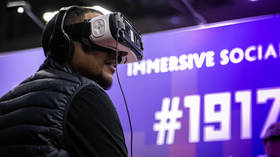Immersive history: #Romanovs100 & #1917LIVE talk future education at SXSW EDU forum

RT projects #Romanovs100 & #1917LIVE have hosted a live panel at one of the biggest educational festivals in America, SXSW EDU, talking about how social media and storytelling could inspire a personal quest for studying history.
Welcoming dozens of guests, the session with the team behind the #Romanovs100 & #1917LIVE educational projects discussed how to repackage conventional study material into more engaging and interactive formats, including virtual and augmented reality (VR/AR), and so enhance enthusiasm for history.
“We are so stunned by the valuable feedback we are getting from many educators, innovators, creators who stop by our stand,” Kirill Karnovich-Valua, the creative director of the projects, said after the session at the SXSW EDU festival in Austin, Texas.
People are very amazed with innovative approach in our storytelling projects and many are really inspired to bring #1917LIVE and #Romanovs100 into their classrooms
🔥Awesome day for the team at #SXSW2019 presenting #1917LIVE#Romanovs100 to #SXSWEDU goers! Stunned by the feedback we are getting. We are almost out of the books but do visit our booth 541 if you are in Austin for @SXSWEDU#SXSW@HelenRappaport@marinamaral2#SXSW2019pic.twitter.com/Oj7rSOXZIw
— Kirill Karnovich-Valua (@KarnovichValua) March 6, 2019
The #1917LIVE and #Romanovs100 projects both told the story of the Revolution of 1917 that did away with monarchy in Russia, but from different angles. The first one was a crowd project on Twitter that simulated all kinds of real participants of those events, from workers to the tsar and from police to the Bolsheviks. The latter focused on the behind-the-scenes life of Nicolas II and his family, the last ruling royals of Russia.
Both projects used social networks as principal operational platforms. This enabled placing history in a new medium. The events that actually took place 100 years ago were re-enacted on the users’ mobile devices in “real time,” with an added feeling of immediacy and urgency about them.
“...not only to restore historical photos, but to give people an opportunity to know more about the people in the photos”Such innovative methods using social media to engage in history education! @Romanovs100#1917Live@marinamaral2@SXSWEDU#reconstructinghistorypic.twitter.com/UeG6RQzTaE
— ReBuild (@ReBuildApp) March 5, 2019
Both the special speakers invited for the session – historian Helen Rappaport and digital artist Marina Amaral – emphasized the role social media and storytelling can now play in education. In a world where we are increasingly surrounded by screens, you need an anchor to trigger personal interest.
I’m a self-professed history geek but know little about the Russian Revolution or The Romanovs. The #1917LIVE & #Romanovs100 projects have certainly piqued my interest to learn more. I imagine they might do the same for other students of history!! #SWSWEdupic.twitter.com/sZujCq7Yz6
— Peter J. LeBlanc (@LeBlancPeter) March 5, 2019
“The number of messages I get from people saying that they started enjoying history only after they found the colorized photos and those made them feel connected to the events, makes me very happy – but also shows that technology exists to [enhance our experience] and help us,” Amaral, who colorized archive images for both #1917LIVE and #Romanovs100, told the conference in a video message.
She acknowledged that her visual work, which she regularly shares on Twitter, has led to numerous requests from teenagers for books on history, as well as from teaching professionals to use her works in classrooms to initiate discussions “that had not existed before.”
#SXSWEDU is lit! Here's 8yo podcaster Nate Butkus @natepodcasts (featured on @TheEllenShow) asking @HelenRappaport a spot-on question at our @SXSWEDU panel on immersive educational storytelling #Romanovs100#1917LIVE@marinamaral2@IvorCrotty@AnyaFedorova_RT#SXSW#SXSW2019pic.twitter.com/9hWg0GMG1Z
— Romanovs100 (@Romanovs100) March 5, 2019
Historian Helen Rappaport, who curated the joint Twitter account of Nicholas II’s four daughters for both projects, pointed out that history can be boring for today’s young learners. But this can be resolved through inventive storytelling.
“You can read conventional history books that look at events in Russia through the eyes of an Emperor or the politicians, but the way I work is to emphasize the actual STORY, and not to sacrifice the momentum of the narrative in order to give a strict chronological presentation of history,” Dr. Rappaport said, answering a question from the audience.
When you look at these private, domestic images taken by the Romanovs, you can see what a devoted and loving family they were. You start uncovering their individual stories. This gave me quite a different perspective on the events that shaped their lives.
“I was not so much interested in the usual attributes and mechanics of monarchy, but in discovering what kind of people the Romanovs really were, their thoughts, their aspirations, their everyday private life is what gave a new meaning to researching their story.”
The Race to Save the Romanovs author Helen Rappaport talks about how history is story - and how Anastasia took the first royal selfie! Great discussion of #Romanovs100 & #1917Live social media projects retelling history through stories, characters, and colorized photos. @SXSWEDUpic.twitter.com/VqltODmOln
— Amy Gillett (@AmyonEducation) March 5, 2019
The award-winning #1917LIVE ran on Twitter exclusively for one year, 2017. Any user could join as a historical character to live through the Russian Revolution of 1917 and tweet on their behalf, as though social media existed 100 years ago. By the end of the project, the community had over 250,000 followers across all the accounts – history students, researchers and teachers among them.
#romanovs100 and #1917LIVE are pushing the limits of bringing history to life in and out of the classroom. Insanely comprehensive social media projects that “remediatize” history. #sxswedu#SXSWEDU2019@SXSWEDUpic.twitter.com/c7MGfOQakX
— Lisa Lightbourn (@lilight) March 5, 2019
It was followed by #Romanovs100, with accounts on four social networks reviewing the last decades of the Russian Empire as seen through the lenses of the Romanov family’s cameras, each platform showcasing its own narrative, format and content. #Romanovs100 features short documentary videos, original music, 100-year-old photos in spherical mobile view, digital colorization, an artwork contest, real-time blogs by historical characters, VR animation and now also an AR photo album.
Also on rt.com #Romanovs100 in AR: RT premiers immersive photo album at SXSW forum in TexasThe team would like to thank everyone who cast their vote for the projects making this panel possible: we were picked out of 1,500 session ideas entered and ran with with over 280 other panels, ranging from Informal Learning to Student Agency, Emerging Tech and others.
Like this story? Share it with a friend!














